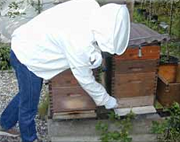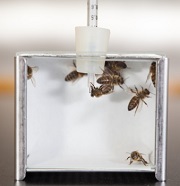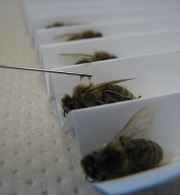- Your Product Type
- Your Study Type
- Aquatic Ecotoxicology
- Aquatic Invertebrates
- OECD 202: Daphnia sp., Acute Immobilisation Test
- OECD 211: Daphnia magna Reproduction Test
- OECD 235: Chironomus sp., Acute Immobilisation Test
- OECD 218/219: Sediment-Water Chironomid Toxicity Test Using Spiked Sediment/Spiked Water
- OECD 233: Sediment-Water Chironomid Life-Cycle Toxicity Test Using Spiked Water or Spiked Sediment
- OECD 225: Sediment-water Lumbriculus Toxicity Test Using Spiked Sediment
- OECD 242: Potamopyrgus antipodarum Reproduction Test
- OECD 243: Lymnaea stagnalis Reproduction Test
- Fish and other vertebrates
- OECD 203: Fish, Acute Toxicity Test
- OECD 215: Fish Juvenile Growth Study
- OECD 212: Fish, Short-term Toxicity Test on Embryo and Sac-fry Stages
- OECD 231: The Amphibian Metamorphosis Assay
- OECD 236: Fish Embryo Acute Toxicity Test
- OECD 210: Fish, Early-life Stage Toxicity Test
- OECD 229 Fish Short Term Reproduction Assay and OECD 230 21-day Fish Assay
- OECD 240 Medaka Extended One Generation Reproduction Test (MEOGRT)
- OECD 248: Xenopus Eleutheroembryonic Thyroid Assay
- OPPTS 850.1500: Fish Life Cycle Toxicity Test
- OÈCD 234 Fish sexual development test
- Aquatic plants
- Analytical Dose Verification
- Aquatic Invertebrates
- Chemistry
- Biodegradation Studies
- Analytical Chemistry Studies and Residues
- Physical-Chemical Properties Studies
- Storage Stability Studies
- OPPTS 830.6302, OPPTS 830.6303,and OPPTS 830.6304: Physical State, Colour and Odor at 20 °C and at 101.3 kPa
- EU A.1: Melting temperature/range
- EU A.2: Boiling temperature
- EU A.3: Relative density (liquids and solids)
- EU A.4: Vapour pressure
- EU A.5: Surface tension
- EU A.9: Flashpoint
- EU A.10: Flammability (solids)
- EU A.12: Flammability (contact with water)
- EU A.13: Pyrophoric properties of solids and liquids
- EU A.16: Relative self-ignition temperature for solids
- EU A.17: Oxidising properties
- OECD 114: Viscosity of Liquids
- Environmental Fate
- Transformation in Soil
- Transformation in Water
- Transformation in Manure
- Adsorption on Soil and Sewage Sludge
- Bioaccumulation and Bioconcentration
- Terrestrial Ecotoxicology
- Non-target Arthropods
- Non-target arthropod testing with the parasitic wasp (Aphidius rhopalosiphi)
- Non-target arthropod testing with the lacewing (Chrysoperla carnea)
- Non-target arthropod testing with the ladybird beetle (Coccinella septempunctata)
- Non-target arthropod testing with the predatory bug (Orius laevigatus)
- Non-target arthropod testing with the predatory mite (Typhlodromus pyri)
- Non-target arthropod testing with the rove beetle (Aleochara bilineata)
- Non-target arthropod testing with the carabid beetle (Poecilus cupreus)
- Non-target arthropod testing with the wolf spider (Pardosa spec.)
- Soil Organisms
- Honey Bees and other Pollinators
- OECD 213/214: Honey bees, Acute Oral and Acute Contact Toxicity Test
- OECD 245: Honey Bee (Apis Mellifera L.), Chronic Oral Toxicity Test (10-Day Feeding)
- OECD 237: Honey Bee Larval Toxicity Test, Single Exposure
- OECD 239: Honey Bee Larval Toxicity Test
- EPPO 170: Honey Bee Field Study – do plant protection products effect honey bee colonies?
- Oomen et al. 1992: Honey Bee Brood Feeding Study
- OECD 75: Honey Bee Brood Test under Semi-field Conditions in Tunnels
- OECD 246/247 Acute Oral and Contact Toxicity to the Bumblebee, Bombus terrestris L.
- Solitary Bee Acute Contact Toxicity Study in the Laboratory (Osmia sp.) Solitary Bee Acute Oral Toxicity Study in the Laboratory (Osmia sp.) (protocols for ringtests with solitary bees recommended by the non-Apis working group)
- SANTE/11956/2016 rev.9 Residue trials for MRL setting in honey
- Non-target plants
- OECD 208: Terrestrial Plant Test - Seedling Emergence and Seedling Growth Test
- OECD 227: Terrestrial Plant Test - Vegetative Vigour Test
- OCSPP 850.4100: Seedling Emergence and Seedling Growth
- OCSPP 850.4150: Vegetative Vigor
- EPPO PP 1/207(2): Efficacy evaluation of plant protection products, Effects on succeeding crops
- Field Studies
- Non-target Arthropods
- Ecological Modelling
- Quality Assurance
- Testing of Potential Endocrine Disruptors
- Aquatic Ecotoxicology
- News
- Company
- Career
- Contact
OECD 213/214: Honey bees, Acute Oral and Acute Contact Toxicity Test
 Plant protection products should be authorized for use only in ways which do not pose an unacceptable risk of harm to honey bees (Apis mellifera). For this purpose, it may be necessary to provide evidence during the registration process to enable the safety of the product in question to be evaluated. This standard test design presents a tiered approach in which basic standard laboratory tests can be used to provide such evidence.
Plant protection products should be authorized for use only in ways which do not pose an unacceptable risk of harm to honey bees (Apis mellifera). For this purpose, it may be necessary to provide evidence during the registration process to enable the safety of the product in question to be evaluated. This standard test design presents a tiered approach in which basic standard laboratory tests can be used to provide such evidence.
Honey bees (A. mellifera) can be exposed to pesticide residues by indirect contact on plant surfaces, via oral intake with contaminated food or water, or by direct contact during the course of application according to normal farming practice. If the proposed use pattern of pesticides indicates a possible exposure of honey bees, acute contact and oral toxicity studies shall be necessary for the registration of the pesticide in question.
Study Design
Test organisms
For these tests young adult worker bees, originated form the IBACON apiary, disease-free and queen-right honey bee colonies are collected in the morning of use from the flight board or the outer honeycombs (away from the brood). They are transferred into test cages in randomised groups of 10 individuals. Collections in winter, early spring or late autumn are avoided as the bees have a changed physiology during this time.
Course of the test
Aim of these tests is the determination of median lethal doses (LD50) for short time exposure of honey bees to the test item by performing dose/response designs. When a substance is expected to be of low toxicity, a limit test may be performed using 100 μg a.i./bee (a.i.=active ingredient) in order to demonstrate that the LD50 is greater than this value. Each test includes the following test groups with 3 (dose response) or 5 (limit test) replicates and with 10 honey bees per replicate:
- Dose Response Test Design: 5 test item dose levels with doses in a geometric series and a dosing factor not exceeding 2.2
Limit Test Design: one single dose of 100 μg a.i./bee in order to demonstrate that the LD50 is greater than this value. - 4 reference item doses with dimethoate as toxic standard in a dose range from ca. 0.1-0.35 μg a.i./bee (a.i. = active ingredient)
- 1 control group with water and if the test item is not water soluble an additional control with a solvent (e.g. Acetone) in the same concentration as used in the test item group
A preliminary non-GLP test with the test item can be conducted to define the optimal dose range.
The usual test duration is 48h and can be prolonged up to 72h or 96h if mortality is increasing between 24/48h or 48/72h.
10 honey bees per replicate are transferred into test cages (size: ca. 8 x 6 x 4 cm). The cages are made of stainless steel, have ventilation holes and a removable glass sheet as front side. They are stored in incubators in the dark (except during observation) at 25 °C and controlled humidity. During the experimental time, the honey bees are fed ad libitum with a 50 % w/v sucrose solution.
 Oral Application (OECD 213)
Oral Application (OECD 213)
Prior to application the honey bees have a starvation time for up to 2 hours for all treatment groups. After that an appropriate amount of 50 % w/v sucrose solution is given into each testing cage in weighed syringes as feeder. For the test item and reference groups the sucrose solution contains the test item or dimethoate in defined concentrations. After uptake of the test item solution is complete or the latest after 6 hours the syringes are removed and weighed again for calculation of real dose uptake. They are replaced by ones containing fresh, untreated food for consumption ad libitum.
 Contact Application (OECD 214)
Contact Application (OECD 214)
Anaesthetized bees are individually treated by topical application with a microapplicator. 10 honey bees per replicate are treated with a single droplet of water, the test item or reference item solution in appropriate concentration, which is applied to the dorsal thorax of the bee. After application the bees are placed in stainless steel cages (size: ca. 8 x 6 x 4 cm) with ventilation holes. The cages are stored in the dark (except observation time) at 25 °C and controlled humidity. For the whole testing period the bees are provided with a 50 % w/v sucrose solution for feeding ad libitum.
Assessment
After 4h, 24h and 48h of application (and also after 72h and 96h for prolonged tests), the test bees are assessed for
- Mortality
- Behavioural abnormalities (e.g. movement coordination problems, apathy)
For the acute oral toxicity tests also the amount of consumed contaminated feeding solution is assessed by weighing the feeders for a calculation of exact dose uptake of the test item.
Endpoints
Results obtained from the bees treated with test item and the reference item will be compared to those obtained from the controls in both the contact and oral tests.
In the case of a dose response test, at least the contact and oral LD50 (24 and 48 hours; 72 and 96 hours, if prolonged) with 95 % confidence limits of the test item and the reference item will be estimated with suitable statistical methods. Other endpoints like a LD20/LD10 or a NOED will be determined, if appropriate.
Guidelines and Literature
- OECD Guideline for The Testing of Chemicals No. 213: "Honey bees, Acute Oral Toxicity Test", adopted 21st September 1998.
- OECD Guideline for The Testing of Chemicals No. 214: "Honey bees, Acute Contact Toxicity Test", adopted 21st September 1998.
